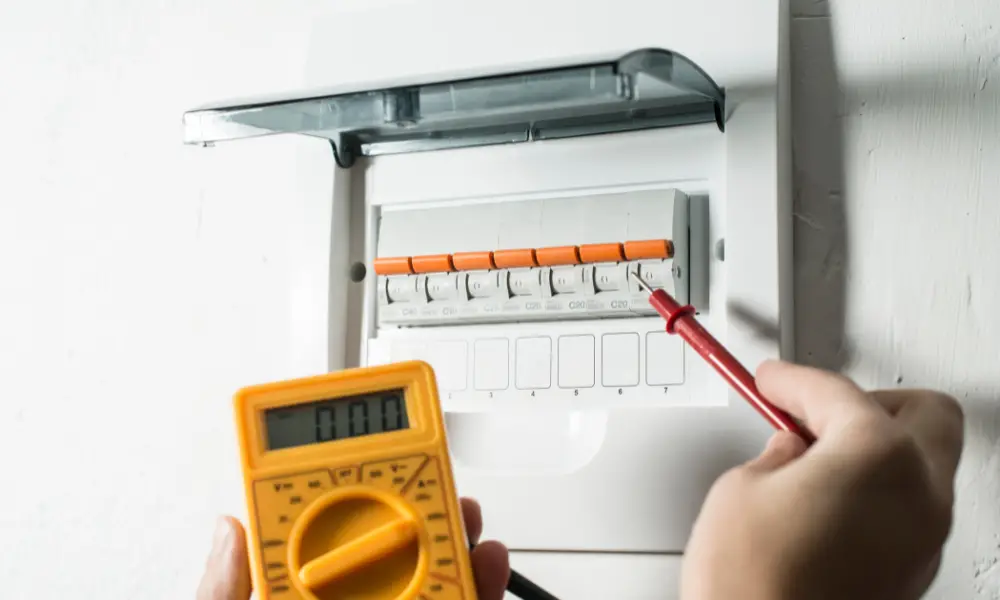Are you tired of those unsightly power lines crisscrossing your backyard, obstructing your view, and limiting your landscape design options?
You might be wondering if it’s possible to move them out of sight or at least to a less conspicuous location.
While relocating power lines may seem like a daunting task, with the right information and professional assistance, it could be achievable depending on various factors such as the type of power line, local regulations, and costs involved.
Before diving headfirst into this project, it’s crucial to understand the potential risks associated with moving power lines and the necessary steps to ensure safety for all parties involved.
Get ready to transform your outdoor space while maintaining electrical safety standards!
Assessing the Situation and Potential Risks

Before diving into the process, it’s crucial to assess the potential risks and challenges involved in moving power lines in your backyard.
Conducting a thorough risk assessment is essential for identifying potential hazards and ensuring that appropriate safety precautions are taken throughout the project.
Begin by familiarizing yourself with your yard layout and noting any underground lines or other obstacles that could pose a threat during the relocation process.
Consult with local utility companies and professional electricians to gain a comprehensive understanding of industry-specific terminology and best practices.
As you evaluate your yard layout, take note of any trees or structures that may interfere with power line relocation. Be aware of the minimum safe distance required between power lines and these objects to reduce potential hazards during installation.
Additionally, consider factors like wind loads, ice accumulation, and other weather-related elements that can impact power line integrity after they’ve been moved.
It’s also important to research local regulations regarding permits or restrictions for altering utility infrastructure on your property.
Once you have a clear understanding of the risks associated with moving power lines in your backyard, develop an action plan outlining each step of the process along with necessary safety precautions.
This should include coordinating with utility companies and hiring qualified professionals who possess extensive experience working on similar projects.
By taking these measures, you’ll be better prepared to navigate this complex undertaking while minimizing potential harm to yourself, others around you, and your property.
Contacting Utility Companies and Professionals

It’s essential to get in touch with utility companies and professionals when considering the relocation of electrical lines on your property.
Utility communication is a vital first step, as it can provide you with information about any potential risks, safety precautions, and permit requirements associated with moving power lines.
Professional consultations can help you better understand the process and give expert recommendations on how to proceed safely and efficiently.
| Utility Communication | Professional Consultations | Safety Precautions |
|---|---|---|
| Discuss potential risks | Expert recommendations | Follow industry standards |
| Identify permit requirements | Evaluate costs & timeline | Utilize proper equipment |
| Coordinate work schedule | Assess feasibility | Adhere to local regulations |
Before making any decisions or starting work on relocating power lines, ensure that all necessary permits have been obtained and safety precautions are in place according to industry-specific guidelines.
Reach out to experts for their advice and guidance throughout the process; their knowledge will be invaluable in ensuring a safe project outcome.
By taking these steps, you’ll be well-prepared for the challenges of moving power lines in your backyard while minimizing risk and adhering to crucial safety regulations.
Evaluating the Costs and Timeframe

Assessing the expenses and duration associated with relocating electrical lines is crucial to proper planning and budgeting for such a project.
Conducting a thorough cost analysis will enable you to understand the various components of the project, such as expense breakdowns for labor, materials, permits, and any required inspections.
Keep in mind that costs can vary significantly based on factors like your location, the complexity of the job, and whether your power lines are overhead or underground.
Furthermore, it’s important to evaluate DIY considerations alongside professional options; while tackling this task yourself might save you money initially, it could also lead to safety hazards or future expenses if not executed correctly.
Timeframe estimation is another key aspect when planning an electrical line relocation project. Consider how long it may take for utility companies to schedule site visits or provide necessary permits before work can begin.
Moreover, accounts for factors like weather conditions that may impact construction timelines.
Also, consider potential delays caused by unforeseen obstacles, such as additional repairs needed once work has started or scheduling conflicts with professionals working on your property.
Once you have established a comprehensive understanding of both cost analysis and timeframe estimations for your power line relocation project, ensure that you’ve considered all permit requirements set forth by local authorities.
Complying with these guidelines will help guarantee a smoother process overall while protecting both yourself and those involved from potential legal ramifications or safety concerns down the line.
While moving power lines in your backyard may be a significant endeavor requiring careful planning and budgeting, taking these steps will ultimately lead to a safer outdoor space tailored specifically to your needs and preferences.
Alternatives to Relocating Power Lines

In some cases, considering alternatives to relocating electrical lines might be a more practical and cost-effective solution.
In fact, around 25% of homeowners opt for strategic landscaping or redesigning their outdoor space instead of moving power lines, creating visually appealing yards without the need for extensive construction work.
Some popular alternatives include underground installation, visual barriers, tree planting, solar panel adoption, and wireless transmission.
| Alternative | Description | Pros & Cons |
|---|---|---|
| Underground Installation | Burying electrical cables under the ground | Pros: Improved aesthetics; protection from weather-related outages Cons: Higher initial costs; potential disruption during installation |
| Visual Barriers | Pros: Environmentally friendly; enhances property value Cons: It takes time for trees to grow; potential hazards with falling branches | Pros: Easy implementation; relatively affordable Cons: Requires ongoing maintenance |
| Tree Planting | Strategically planting trees to obscure power lines | Pros: Eliminates the need for physical cables; Cons: Currently expensive and not widely available |
| Solar Panel Adoption | Installing solar panels on your property as an alternative energy source | Pros: Reduces dependence on grid electricity; lowers energy bills; Cons: High upfront costs; requires professional installation |
| Wireless Transmission | Transitioning to wireless energy systems that don’t rely on physical connections | Pros: Eliminates need for physical cables; Cons: Currently expensive and not widely available |
Rather than going through the hassle and expense of relocating power lines in your backyard, consider these alternatives as they might offer a more suitable solution.
Keep in mind that each option has its pros and cons, so it’s essential to weigh them based on your specific needs and preferences.
With careful planning and creative thinking, you can achieve both functional improvements and aesthetic enhancements to your outdoor space without the need to move power lines.
Conclusion
So, you thought moving power lines in your backyard would be a breeze, didn’t you? Well, as we’ve seen, it’s quite an intricate process.
It involves the assessment of risks, contacting utility companies and professionals, as well as evaluating costs and timeframes.
But hey, who doesn’t love a good challenge? At least now you’re well-versed in industry-specific terminology and have a deeper understanding of the technical aspects.
Just remember to consider alternatives before diving into this electrifying endeavor!





